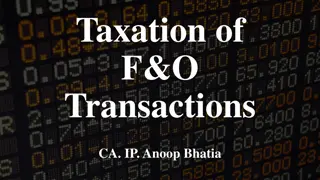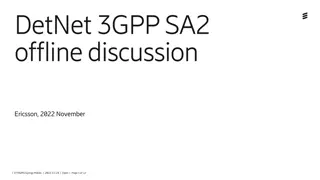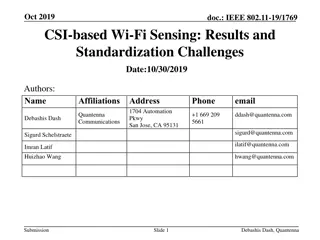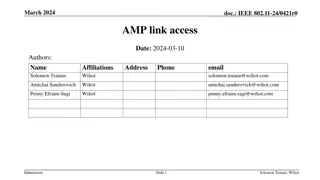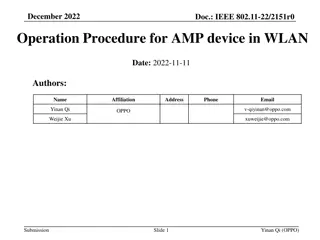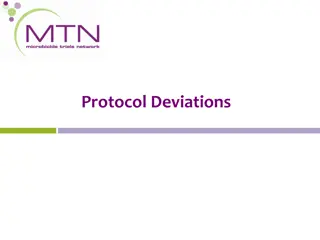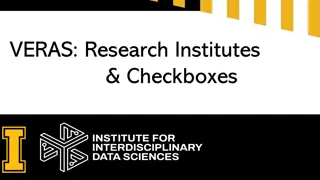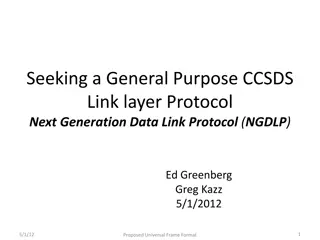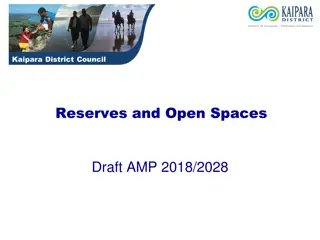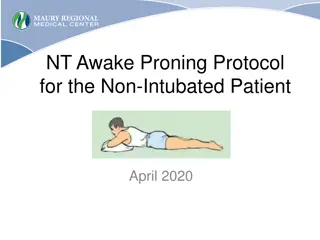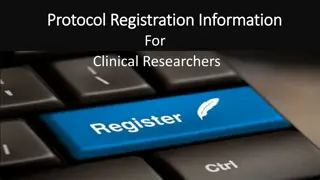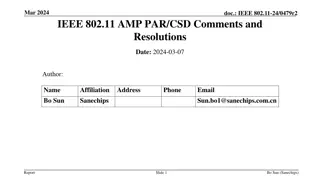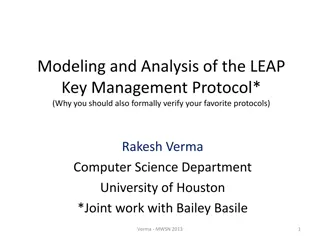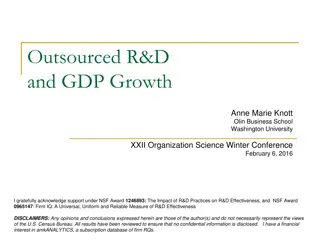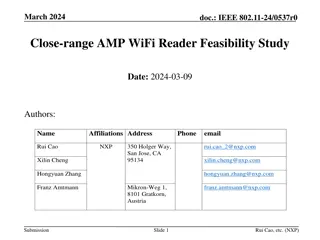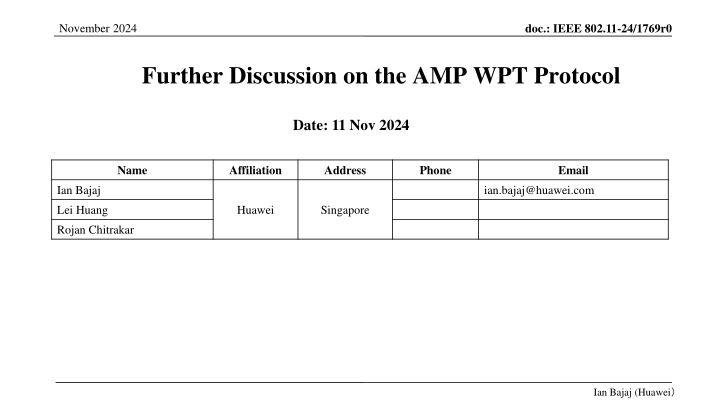
IEEE 802.11-24/1769r0 WPT Protocol Discussion and Consensus November 2024
"Explore the in-depth discussion on the IEEE 802.11 WPT protocol for wireless power transfer, including conditions, control, and consensus parameters crucial for RF energy harvesting. Delve into the detailed aspects and consensus-building efforts within the group. Join the conversation on WPT protocol advancements in November 2024."
Download Presentation

Please find below an Image/Link to download the presentation.
The content on the website is provided AS IS for your information and personal use only. It may not be sold, licensed, or shared on other websites without obtaining consent from the author. If you encounter any issues during the download, it is possible that the publisher has removed the file from their server.
You are allowed to download the files provided on this website for personal or commercial use, subject to the condition that they are used lawfully. All files are the property of their respective owners.
The content on the website is provided AS IS for your information and personal use only. It may not be sold, licensed, or shared on other websites without obtaining consent from the author.
E N D
Presentation Transcript
doc.: IEEE 802.11-24/1769r0 November 2024 Further Discussion on the AMP WPT Protocol Date: 11 Nov 2024 Name Affiliation Address Phone Email Ian Bajaj ian.bajaj@huawei.com Lei Huang Huawei Singapore Rojan Chitrakar Ian Bajaj (Huawei
doc.: IEEE 802.11-24/1769r0 November 2024 WPT in TGbp Wireless Power Transfer (WPT) is defined in the IEEE 802.11 TGbp PAR [1] There is growing interest in the group on the topic, with more contributions seen on WPT in September telecon and F2F alone: 11-24/1381r0, AMP Device Power Status 11-24/1520r0, Charging and Discharging Intervals in Passive AMP STAs 11-24/1524r2, Follow-up on the AMP WPT protocol 11-24/1539r0, Energy-Level Status Reporting for AMP Devices 11-24/1536r0, Wireless Power Transfer for AMP 11-24/1551r0, WPT waveform discussion 11-24/1561r1, AMP Power Budget Negotiation The purpose of this contribution is to clarify the WPT protocol, and to reach a consensus in the group on the different aspects of this protocol. Ian Bajaj (Huawei Slide 2
doc.: IEEE 802.11-24/1769r0 November 2024 WPT Protocol (1/2) Wireless Power transfer (WPT) in our understanding is an active transfer of power from a transmitting source (AP/Energizer) to a receiving node (AMP STA). Passive EH (Energy Harvesting) is more like a Wireless Power Receiver. Therefore to define a WPT Protocol, is to define the conditions for power transfer, and the control over this power transfer. Conditions Insufficient energy at AMP STA Higher duty cycle requirement (implying quicker charging cycle) Change in charging link, path loss/fading/AMP STA mobility WPT management frame exchange between AP and AMP STA Control Transmission power Duration Interval (one-time trigger with instructions to match a duty cycle) WPT control signal from the AP to the energizer for a non-collocated architecture Step 2 Definition WPT Protocol equivalent Step 1 Ian Bajaj (Huawei Slide 3
doc.: IEEE 802.11-24/1769r0 November 2024 WPT Protocol (2/2) Step 2 Provide the control for WPT Step 1 Determine the conditions/ requirements for WPT Ian Bajaj (Huawei Slide 4
doc.: IEEE 802.11-24/1769r0 November 2024 WPT Protocol Consensus Discussion (1/3) Step 1 The WPT protocol defines a procedure that allows an AMP STA to report RF-EH related information. RF-EH RF Energy Harvesting Step 1a Reach a consensus in the group on the crucial RF-EH parameters RF-EH Related Candidate Parameters to be reported Reporting Priority (Our view) Reporting Frequency [2] [3] [4] [5] [6] High Once Energy Storage Capacity High Ongoing / Periodic Available Energy (Correction Parameter) Medium Once Operating Modes Medium As requested Operating Duration Medium Once Operating Power (Charging, Discharging Rate) Low Once EH operating frequency High As requested Received Power (Harvested Power) Medium Ongoing / Periodic Buffer Data Size Ian Bajaj (Huawei Slide 5
doc.: IEEE 802.11-24/1769r0 November 2024 WPT Protocol Consensus Discussion (2/3) Step 1b How is RF-EH related information reported by the AMP STA? [5] discusses three options for RF-EH reporting: Option 1 (O1): Piggyback RF-EH related report with TX payload Option 2 (O2): AP-triggered RF-EH related report in an AMP STA Response Option 3 (O3): AMP STA initiated RF-EH report (for AMP assisting STAs only) General consensus in the group is piggybacked reporting (O1) does not consume additional power, and is likely to be supported. However, as presented in [4], the piggybacked EH report does not serve a purpose in low duty cycle operations. AP-triggered EH reports (O2) is more applicable for low duty cycle operations, and consumes negligible power on average [4]. O3 maybe applicable only for AMP assisting STAs that can contend for TXOP. Ian Bajaj (Huawei Slide 6
doc.: IEEE 802.11-24/1769r0 November 2024 WPT Protocol Consensus Discussion (3/3) Step 2 WPT protocol defines a procedure allowing the AP to send control information to the AMP Energizer. The necessity for AMP Energizer control for a non-collocated Energizer is discussed in [4]. Control information from an AP can enable an Energizer to change its PPDU related transmission parameters to alter its PPDU type, and/or transmission power, duration and interval of charging as discussed in [7]. Ian Bajaj (Huawei Slide 7
doc.: IEEE 802.11-24/1769r0 November 2024 Summary The WPT Protocol is defined which includes: Step 1 WPT management frame exchange between AP and AMP STA Step 2 WPT control signal from the AP to the energizer for a non- collocated architecture Several RF-EH related candidate parameters for AMP STA reporting along with their reporting frequency was discussed. Three options for reporting the RF-EH related information was discussed. Ian Bajaj (Huawei Slide 8
doc.: IEEE 802.11-24/1769r0 November 2024 SP1.1 Do you agree to add the following text to TGbp SFD? IEEE 802.11bp shall define a WPT protocol which comprises a procedure allowing an AMP STA to report to the AP its RF-EH related information. RF-EH related information is TBD. RF-EH RF Energy Harvesting Ian Bajaj (Huawei Slide 9
doc.: IEEE 802.11-24/1769r0 November 2024 SP1.2 Do you agree to add the following text to TGbp SFD? The AMP STA shall report to the AP, RF-EH related parameters which includes one or more of the following: energy storage capacity, available energy, and/or received power from RF-EH. Ian Bajaj (Huawei Slide 10
doc.: IEEE 802.11-24/1769r0 November 2024 SP1.3 Do you agree to add the following text to TGbp SFD? An AMP STA may report one-time or ongoing RF-EH related information through one or more of the following procedures: Option 1 (O1): Piggyback RF-EH related report with TX payload Option 2 (O2): AP-triggered RF-EH related report in an AMP STA Response Option 3 (O3): AMP STA initiated RF-EH report O3 is only applicable for AMP assisting STAs Ian Bajaj (Huawei Slide 11
doc.: IEEE 802.11-24/1769r0 November 2024 SP2 Do you agree to add the following text to TGbp SFD? IEEE 802.11bp shall define a WPT protocol which comprises a procedure allowing the AP to send control information to the AMP Energizer. The control information is TBD. Ian Bajaj (Huawei Slide 12
doc.: IEEE 802.11-24/1769r0 November 2024 References [1] 11-24/0575r1, P802.11bp PAR. [2] 11-24/1381r0, AMP Device Power Status [3] 11-24/1520r0, Charging and Discharging Intervals in Passive AMP STAs [4] 11-24/1524r2, Follow-up on the AMP WPT protocol [5] 11-24/1539r0, Energy-Level Status Reporting for AMP Devices [6] 11-24/1561r1, AMP Power Budget Negotiation [7] 11-24/1767r0, AMP Energizer Ian Bajaj (Huawei Slide 13

